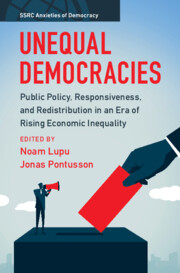 Unequal Democracies
Unequal Democracies Book contents
- Unequal Democracies
- SSRC Anxieties of Democracy
- Sponsored by the Social Science Research Council
- Unequal Democracies
- Copyright page
- Contents
- Figures
- Tables
- Contributors
- Acknowledgments
- 1 The Political Puzzle of Rising Inequality
- Part I Government Responsiveness
- Part II Political Inequality and Representation
- Part III Voters and Demand for Redistribution
- Bibliography
- Index
- References
Bibliography
Published online by Cambridge University Press: 07 December 2023
- Unequal Democracies
- SSRC Anxieties of Democracy
- Sponsored by the Social Science Research Council
- Unequal Democracies
- Copyright page
- Contents
- Figures
- Tables
- Contributors
- Acknowledgments
- 1 The Political Puzzle of Rising Inequality
- Part I Government Responsiveness
- Part II Political Inequality and Representation
- Part III Voters and Demand for Redistribution
- Bibliography
- Index
- References
Summary
- Type
- Chapter
- Information
- Unequal DemocraciesPublic Policy, Responsiveness, and Redistribution in an Era of Rising Economic Inequality, pp. 325 - 358Publisher: Cambridge University PressPrint publication year: 2023
- Creative Commons
- This content is Open Access and distributed under the terms of the Creative Commons Attribution licence CC-BY-NC 4.0 https://creativecommons.org/cclicenses/


